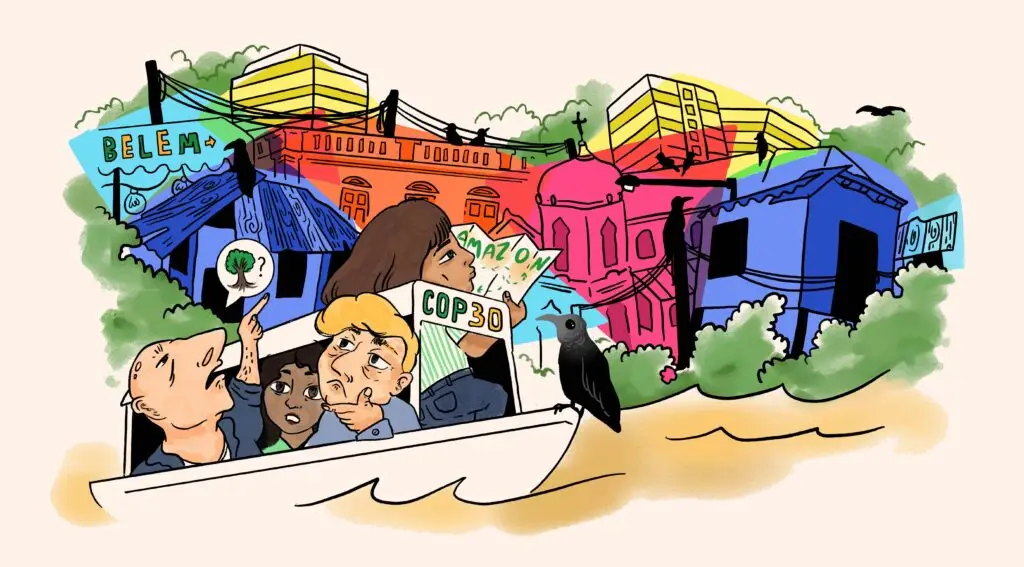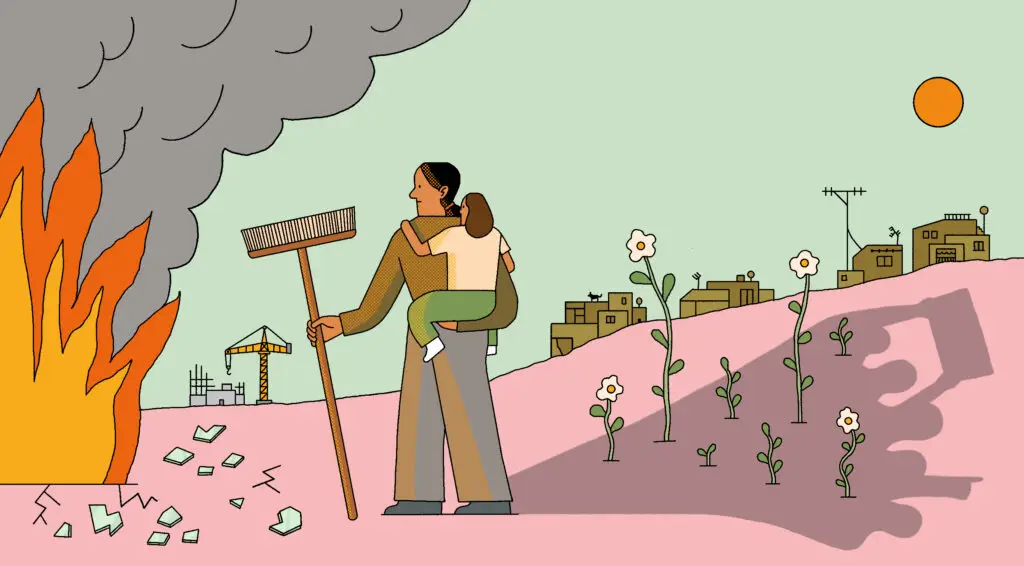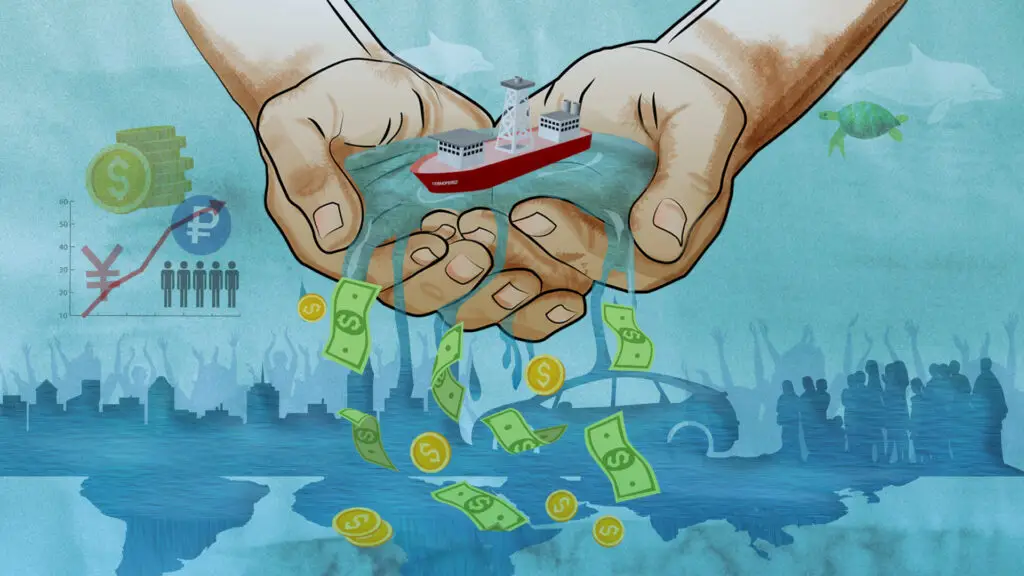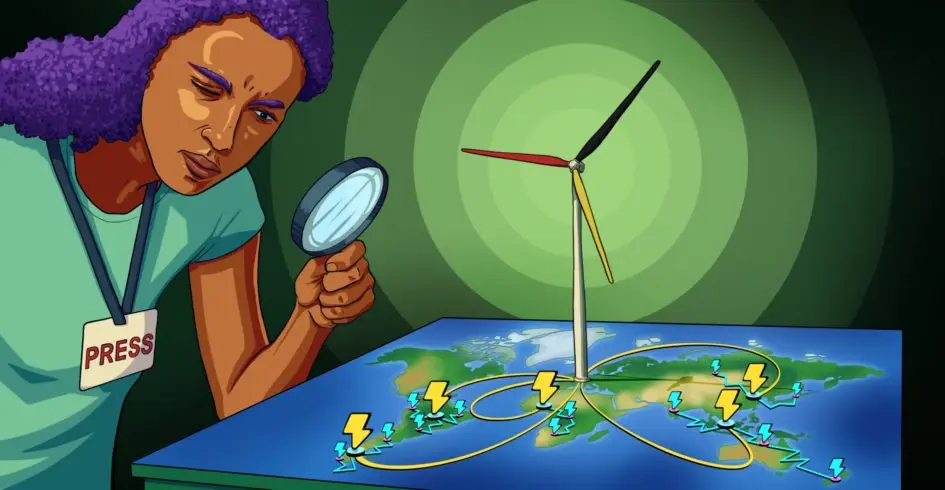
Can green hydrogen tackle Nigeria’s persistent energy poverty?
- Written by Immaculata Abba
- Illustration by Charity Atakunda
Before Nigeria starts exporting more energy in the form of green hydrogen a question remains: can it secure electricity for its own population?
Read this article in German.
When I was growing up in the 1990s, the National Electric Power Authority (NEPA) was nicknamed “Never Expect Power Always.” Today, NEPA (later PHCN) has been privatised and unbundled into six-generation companies and eleven distribution companies. Still, Nigerians on Twitter will tell you “that siren sound when NEPA brings light is one of the few things that give Nigerians happiness.” Nigerians continue to never expect power, always.
With the rising urgency of the Climate Crisis, green hydrogen is the shiniest newcomer in global conversations on energy production. However, with sub-Saharan African countries contributing less than 3% (0.2% for Nigeria) to global carbon emissions, the more pressing question is how the continent can harness its existing resources to sustainably meet its own energy demand for economic development and poverty reduction.
Following a recent green hydrogen partnership between Germany and Nigeria, the imminent question is: can the production (& export) of green hydrogen tackle Nigeria’s energy poverty, particularly in rural and off-grid areas?
To answer this requires considering three issues: energy poverty and development in Nigeria, green hydrogen as a climate-friendly option in Nigeria’s infrastructural development, and the terms of the Germany-Nigeria partnership.
Nigeria’s Energy Problem
What exactly is the scope of Nigeria’s energy problem? Nigeria generates between 3,500 megawatts (MW) and 5,000MW of electricity, while it has a generating capacity of 22,000MW and a demand of 200,000MW. But even if the generating capacity was improved, Nigeria’s transmission capacity hovers between 7,500MW and 8,000MW. And so more than 85 million people in Nigeria (43% of the country’s population) do not have access to the national electricity grid. And even for those on the grid, power outages are all too common. In 2020, the World Bank’s Ease of Doing Business report ranked Nigeria 171 out of 190 countries in terms of electricity access.
Nigeria’s Minister of Power, Abubakar Aliyu, once explained that the unstable electricity was a result of the drop in the level of water (due to the Harmattan season between November and March during which intense dry, dusty wind blows from the Sahara over West Africa) as well as gas shortages and maintenance problems with the electricity generators. Currently, fossil fuels account for over 80% of Nigeria’s generation capacity.
But this is not unusual for a West African country. Only 42% of people in the ECOWAS region have access to nationally-provided electricity.
To address this, the ECOWAS commission embarked on a Regional Off-Grid Electrification Project (ROGEP) in 2017. It was originally scheduled to end in 2021 but was relaunched in 2022.
Similarly, in Nigeria, the government’s current solution to its energy problem is dual-pronged: improve the national grid’s capacity while creating mini-grid solutions for off-grid (typically rural) areas. However, off-grid solutions usually come with higher tariffs, and consumers have little to no communication channels for complaints and concerns.
As Nigerians wait for the reality of a steady power supply, in the meantime, we turn to generators, power inverters, solar, and other backup power sources to make do. As of 2015, the average Nigerian was spending three times more on backup power than on electricity supplied by the grids.
Green hydrogen, a new solution?
Scientists say that green hydrogen has the potential to replace oil, gas, and coal in small and big energy use cases, from mini-grids to industrial manufacturing.
What’s great? Green hydrogen—the category of hydrogen extracted from water, as opposed to fossil fuels, and produced mostly using renewable power sources (solar, wind, geothermal)—does not emit carbon when it’s used.
Hydrogen could act as an energy carrier, like a battery, that allows the storage of excess energy created by renewables.
What’s not great? Economic viability is the most significant obstacle facing any hydrogen project (regardless of the colour label). It is costly to repurpose oil and gas infrastructure to make it safe for hydrogen, as hydrogen is highly flammable and corrosive. This is no modest obstacle; the Namibian government estimates it will need $190 billion by 2040 (or $11 billion per year) to finance its ambitious green hydrogen plans. For context, Nigeria’s 2023 budget for its entire power sector is only half a billion dollars.
Additionally, scientists do not recommend green hydrogen as a more efficient alternative for use cases with lower energy needs, such as in rural and off-grid areas. According to Robert Howarth, professor of ecology and environmental biology,
“Direct electrification and batteries offer so much more, and much more quickly. It’s a huge distraction and waste of resources to even be talking about heating homes and passenger vehicles with hydrogen.”
Robert Howarth, Cornell University
Also, for the environment, hydrogen is not harmless. Even though it is not a greenhouse gas, it aggravates some greenhouse gases in ways that compound their carbon footprints. For example, it causes methane (which warms the planet faster than CO2) to stay in the atmosphere for longer. In addition, it takes more energy to produce, store, and transport hydrogen than hydrogen itself provides when converted into useful energy. Its advantage above other fuels is largely limited to its capacity to act as a storage unit.
Great expectations: The German-Nigerian energy partnership
As hydrogen is playing a key role in the context of Germany’s energy transition, the German government earmarked €2 billion in 2020 to build up green hydrogen partnerships with other countries. A primary objective of these partnerships is to (eventually) import hydrogen from these other countries.
In November 2021, Germany’s Federal Foreign Office, in collaboration with the Deutsche Gesellschaft für Internationale Zusammenarbeit (GIZ), opened a Germany-Nigeria Hydrogen office in Nigeria to expand the activities of the German-Nigerian energy partnership, which has been in place since 2008. The office frames its hydrogen partnership with Nigeria as an intervention on forecasted economic and political challenges that fossil fuel-exporting economies may likely face in the emerging global decarbonization trends.
By way of expectations, both Nigerian and German officials are optimistic. At the office’s opening event in May 2022, a representative of the Ministry of Environment explained that this partnership “is expected to align with Nigeria’s nationally determined contribution to ensure we are set on the path of a green future.” And at the just concluded 6th Nigeria International Energy Summit (April 2023), the country director of GIZ Nigeria and ECOWAS, Markus Wagner, spoke on the German-Nigerian green hydrogen partnership, saying:
“The nascent low-carbon hydrogen economy and its associated industries hold the promise of economic growth, industrialization, added-value creation, decent job generation, infrastructure development, and an increased access to secure and affordable low-carbon energy.”
Markus Wagner
Unlike in Namibia, where Germany has publicly declared funding agreements (EUR 40 million as of August 2021), the Germany-Nigeria hydrogen office has not declared any such funding for Nigeria. Rather, the office declares its objectives as networking among experts and key stakeholders, raising awareness, providing technical assistance, facilitating public and private sector cooperation, and supporting trade and economic cooperation between Germany and Nigeria on the potential of green hydrogen production and application in Nigeria. It had its first public symposium in May 2022.
Essentially, this partnership is still in its nascent days. Given the critical challenge of economic viability stated earlier, the main obstacle to mobilising hydrogen production through this partnership would be financing.
Legacy of Extraction
With this German partnership, Nigeria is being offered the opportunity to join the global ‘race’ to develop green hydrogen. This has the potential to boost energy production and stimulate economic growth in general, which could, in turn, benefit rural and off-grid areas. We see this potential in Namibia, another African country leading the green hydrogen revolution, where members of the Lüderitz town, where a green hydrogen project is being proposed, have high hopes and excitement over the project’s opportunity to train and employ local people.
However, it is key to note that this correlation is not direct, and other factors, such as resource management and allocation, could stand in the way of rural and off-grid areas reaping benefits.
Previously, large resource-extractive projects in Nigeria have not invested back into the community as hoped. The Niger Delta conflict is the most obvious example, which arose in the 1990s over tensions between foreign oil corporations and indigenes in the region.
Furthermore, the historical parallels between this green hydrogen ‘race’ and other extractives between Europe and Africa should be enough for us to pay closer attention. William Montieth (senior lecturer in Human Geography at Queen Mary University of London, whose research focuses on the experiences of ‘make do’ at the margins of capitalist economies) explained during a call that “dominant discourses of the ‘green hydrogen rush’ present Africa as the solution to European carbon consumption and energy dependency.” He added that “thinking historically and geographically about green hydrogen illustrates the continued role of [post-colonial] extractivism and expropriation within green energy transitions.”
The Gbamu-Gbamu case study
In December 2022, the Delegation of German Industry and Commerce in Nigeria conducted a feasibility study of green hydrogen production for use in off-grid applications in Nigeria. Using the Gbamu Gbamu community, a remote community in Ijebu East Local Government Area of Ogun State operating an 85kWp solar mini-grid, they argued that green hydrogen as a means of electricity storage is a financially feasible solution. But, they point out that this solution is only feasible because fuel, transportation, and diesel generator maintenance are currently expensive anyway.
However, that hydrogen might be competitive with other fuel costs does not necessarily mean that community members are willing or able to spend on either hydrogen or the current expensive options.
Back in 2021, Uchechukwu Okoro, a Renewable Energy Analyst, observed that “the only businesses using considerable electricity during the day were service providers such as bet shops, videogame operators, barbing salons, and restaurants.” Mini-grid communities like Gbamu-Gbamu tend to have low economic activity and low disposable income. Tariffs are also higher for mini-grid consumers, and so force them to economise their energy use. These factors throw the financial feasibility of hydrogen production and consumption/use there into doubt.
In conclusion, three things stand out: one- If Nigeria generates more energy than it can transmit, it will still need to resolve its transmission problem for Nigerians to get more access to electricity supply. Two- Green hydrogen is not economically viable for use cases in low-energy demand areas such as rural and mini-grid communities. Three- the green hydrogen discourse echoes extractive trade patterns between Africa and Europe. There will be no one panacea for Nigeria’s energy poverty problem. But for green hydrogen to be included in the mix of solutions, these three things will need to be considered seriously in the conversation.
About the Author
Read more in this series:
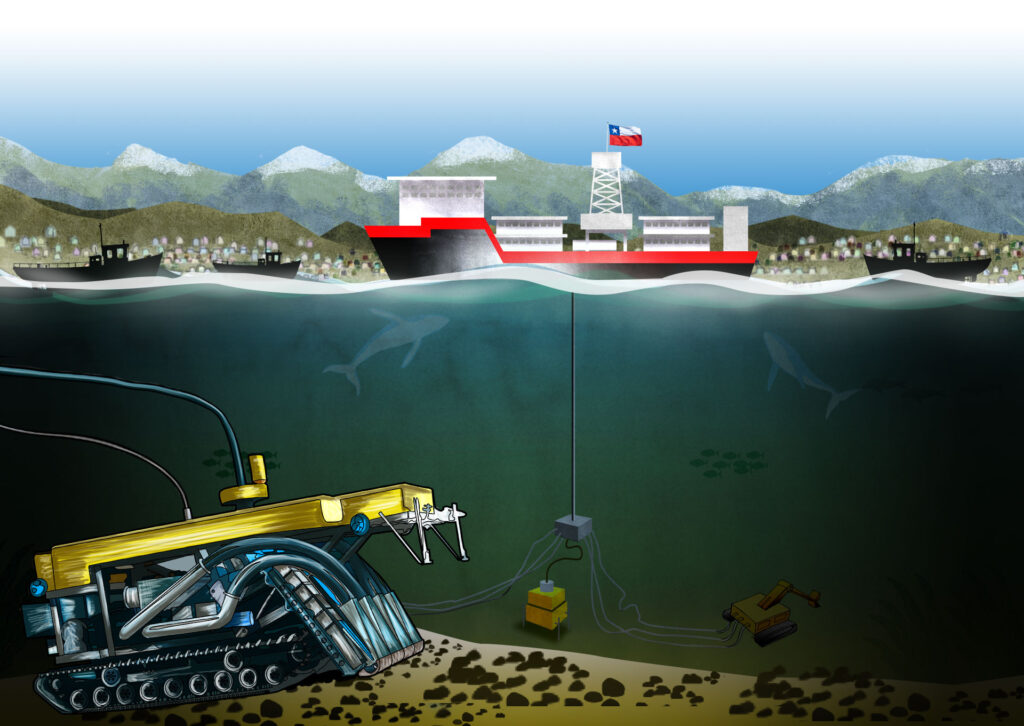
After the international negotiations on deep sea mining, it is worth asking whether this activity could be developed in the future in Chile, a mining country whose sea is almost five times larger than its continental surface. While some say that “it does not make sense”, others suggest that it could be an alternative to reduce land-based mining conflicts.
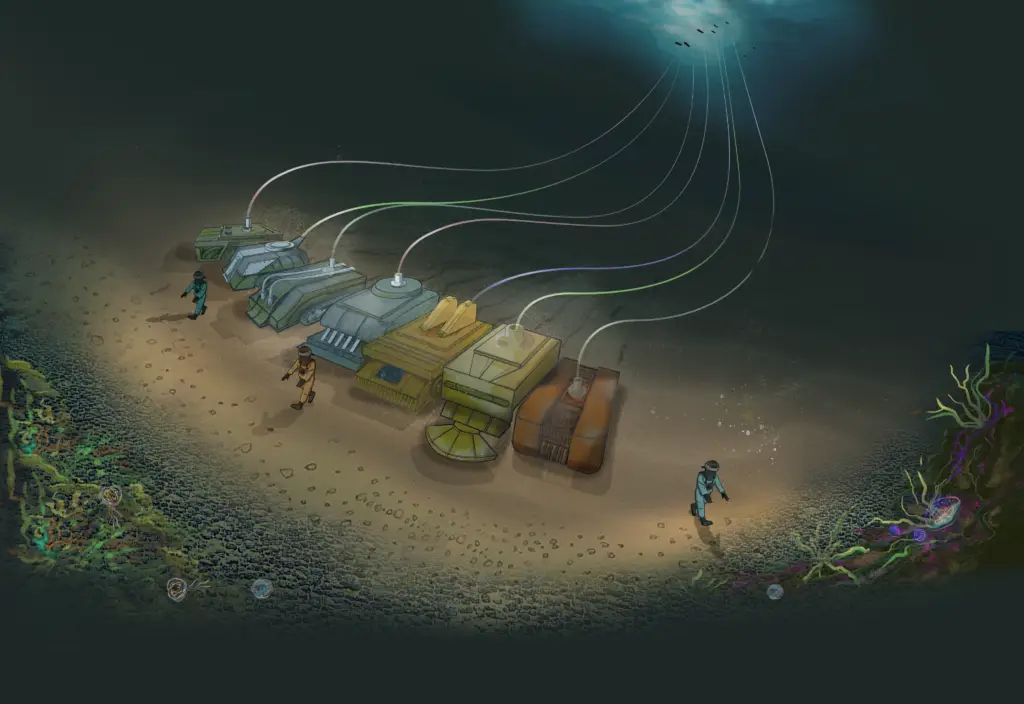
Proponents say that mining the deep seas will provide a nearly unlimited resource of valuable metals, solving the problem of where to get the materials needed for the green energy transition, with the profits shared by all mankind. However, the pressing question remains: Can we justify the costs?

This project was funded by the European Journalism Centre, through the Solutions Journalism Accelerator. This fund is supported by the Bill & Melinda Gates Foundation.



